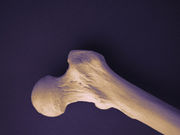Treatment-related increases in total hip bone mineral density linked to reduced fracture risk
WEDNESDAY, July 20, 2016 (HealthDay News) — For women initiating osteoporosis treatment, treatment-related changes in total hip bone mineral density (BMD) are associated with fracture risk, according to a study published online July 19 in the Annals of Internal Medicine.
William D. Leslie, M.D., from the University of Manitoba in Winnipeg, Canada, and colleagues examined repeated BMD testing as an indicator of treatment-related fracture risk reduction in a registry-based cohort study. Data were included for 6,629 women aged 40 years or older initiating osteoporosis treatment with two consecutive dual-energy X-ray absorptiometry scans.
The researchers found that 13.7 percent of women (910 women) developed incident fractures during a mean of 9.2 years, including 198 hip fractures. Women with a detectable decrease in total hip BMD had an absolute increase of 2.9 and 5.5 percent in the five- and 10-year cumulative incidence of any fracture, respectively, compared with stable BMD, after adjustment for baseline fracture probability. For women with a detectable increase in total hip BMD, the risk for any fracture was 1.3 and 2.6 percent lower after five and 10 years, respectively. The results were consistent for change in femoral neck and lumbar spine BMD and across subgroup analyses.
“Monitoring BMD in clinical practice may help to identify women with a suboptimal response to osteoporosis treatment,” the authors write.
Several authors disclosed financial ties to the pharmaceutical industry.
Full Text (subscription or payment may be required)
Copyright © 2016 HealthDay. All rights reserved.








